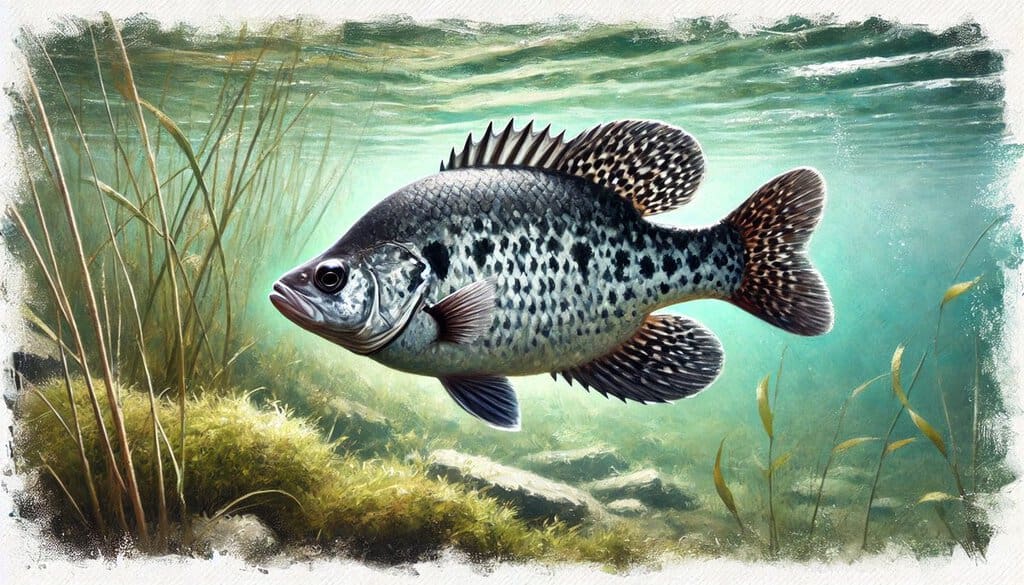Black Crappie is a popular freshwater fish species in North America, valued for both sport fishing and aquaculture. Its adaptability to various water conditions and relatively fast growth rate make it interesting for aquaponics systems. Black Crappie is known for its delicious white flesh and is considered a valuable food fish.
Natural Habitat and Behavior
Origin and native environment: Black Crappie is native to eastern and central North America, typically found in lakes, ponds, and slow-moving rivers[1].
Natural behavior in the wild: They are known to form schools and prefer areas with submerged vegetation or structures.
Temperament: Generally peaceful, but may become territorial during breeding seasons.
Compatibility: Can be kept with other non-aggressive fish species of similar size.
Water Requirements
Temperature Range: Ideal: 18-24°C (64.4-75.2°F), extremes can affect growth and reproduction
pH Level: Recommended range: 6.5-8.5, tolerant of slight fluctuations
Water hardness: Prefers moderately hard water
Oxygen Levels: Requires well-oxygenated water, minimum dissolved oxygen: 5 mg/L
Ammonia/Nitrate Sensitivity: Sensitive to high ammonia levels, keep ammonia below 0.02 ppm and nitrite below 0.1 ppm
Tank or Pond Setup
Tank/Pond Size Requirements: Minimum 1000 liters (264 gallons) for a small group, allow at least 40 liters (10.5 gallons) per adult fish
Filtration & Aeration: Requires efficient filtration and good water circulation
Lighting Considerations: Prefers moderate lighting; avoid intense direct light
Tank Decorations/Substrate: Provide submerged structures and vegetation for hiding and breeding
Feeding Requirements
Diet: Omnivorous, with a preference for small fish and insects. Can be fed commercial pellets supplemented with live or frozen foods in aquaponics.
Feeding Techniques: Feed 2-3 times daily, offer a variety of foods for optimal nutrition
Supplements: May benefit from vitamin supplements, especially during breeding seasons
Growth and Reproduction
Growth Rate: Moderate growth rate, reaching 20-30 cm (8-12 inches) in 2-3 years
Physical Growth Indicators: Develop darker coloration and more defined patterns as they mature
Breeding Behavior: Spawn in spring when water temperatures reach 14-20°C (57.2-68°F), males build nests in shallow water
Care of Fry: Fry require special care and should be separated from adults. Feed newly hatched brine shrimp and/or commercial fry food
Harvesting & Culinary Considerations
Growth to Harvest: Typically harvested at 20-25 cm (8-10 inches), usually after 2-3 years
Culinary Uses: Mild, sweet flavor; popular for frying or grilling
Recommendations for Ethical Harvesting: Use quick and humane methods to minimize stress
Pros and Cons
- Adaptable to various water conditions
- Valuable food fish
- May require larger system due to size
- Can be sensitive to water quality fluctuations
Overall Suitability: Best for intermediate to advanced aquaponics practitioners
Common Health Issues
Potential Diseases: Susceptible to common freshwater fish diseases, stress can lead to increased disease susceptibility
Signs of Health Issues: Loss of appetite, abnormal swimming behavior, visible lesions
Treatment Recommendations: Maintain water quality and consult a fish health specialist for specific treatments
Maintenance Tips for Long-Term Health
Maintenance Frequency: Regular water quality testing and system checks
System checks: Monitor temperature, pH, and dissolved oxygen levels daily
Handling Practices: Minimize handling to reduce stress
Winter/Summer Care: Ensure stable temperatures during extreme weather
Closing Thoughts
Black Crappie can be an interesting addition to larger aquaponics systems, especially for those interested in cultivating a valuable food fish. However, their specific care requirements and potential size make them more suitable for experienced aquaponics practitioners. Further research and experimentation are needed to optimize Black Crappie cultivation in aquaponics settings.
Additional Resources/References
For more detailed information on Black Crappie biology and management, consult fisheries and aquaculture journals or extension services from universities in regions where Black Crappie is native.
Other fish species for aquaponics
External sources:
[1] https://www.semanticscholar.org/paper/6821de39ece60a151c3dc024a0fa9da9e20e2716
[2] https://www.semanticscholar.org/paper/26dd788010c4d036fdcd7aeb64382f5767df865a
[3] https://www.semanticscholar.org/paper/a755e04bfb43b4d8901110c8bc68417f9545cac2
[4] https://www.semanticscholar.org/paper/120a3fc5718aa2156d12bb7aff8435b3ddbf9ee2
[5] https://pubmed.ncbi.nlm.nih.gov/35553361/
[6] https://www.ncbi.nlm.nih.gov/pmc/articles/PMC10662609/
[7] https://www.semanticscholar.org/paper/0cd68a6ef198205d0e50e4ca30614e0028e5a2bc

